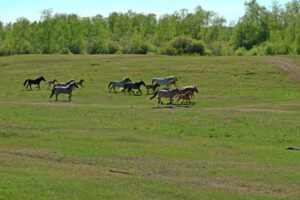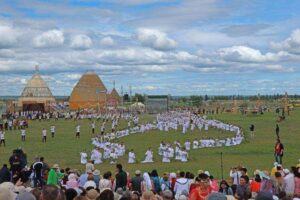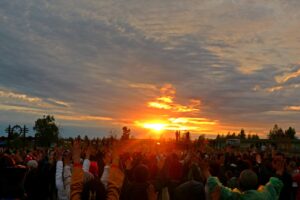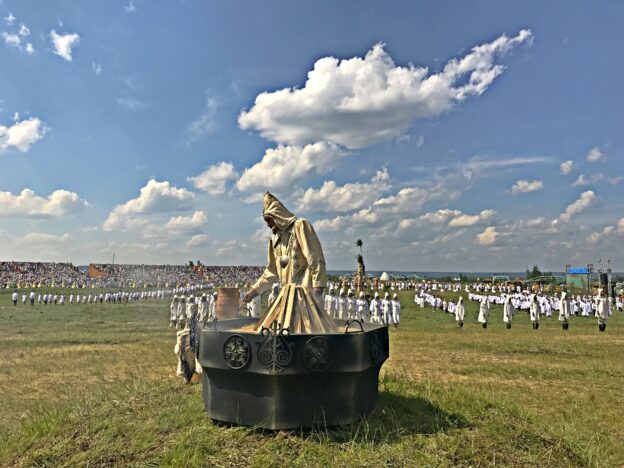For centuries, even for millennia, human life and activities have been measured in time. While the majority of people are now used to the standardised units of time, such as seconds, minutes, hours, days, months, and years, the organisation of these units through calendars can be very diverse. There are over forty calendars in use today. Some of them are sun-based, like the Gregorian solar calendar used in the UK since 1750. There are also lunisolar calendars that follow the movements of the moon, like the Chinese, Jewish, and Islamic calendars.
Religion is closely intertwined with the organisation of calendars. Holidays in different countries can indicate which religion has the strongest presence in the nation-state. In most European countries, for example, Christmas and Easter are the largest public holidays indicating the strong presence of Christianity in Europe.
Another example is when the Soviet Union introduced new holidays to replace the Orthodox Christian ones following the Russian Revolution in 1917. This measure was supposed to mark the transition from the “dark religious” Russian Empire to the “modern secular” Soviet state, where religion was regarded as “the opium of the people.”
The names of the units of time can also inform about the main activities of the people. The calendar of the Sakha (Yakut) people from North-East Asia, for instance, reflects environmental and agricultural cycles central to the life of the Sakha. This is particularly evident in the Sakha names of months:
Kulun Tutar yia [March] – the month of foal catching.
Sakha people have been historically horse herders and have incorporated products made from mare’s milk into their diet. During this month, foals are captured and separated from the mares to facilitate the milking process. Kymys, a drink made from fermented mare’s milk, is not only a local delicacy but an important part of Sakha ceremonies and festivities.

Figure 1. Running foals of the Sakha breed (all photos are taken by the author)
Muus ustar yia [April] – the month of ice drift.
Sakha Sire [Sa. ‘the land of the Sakha’] is located in one of the coldest regions of the planet, where rivers and lakes freeze during the winter months. The thawing of the Lena River, one of the largest rivers in the world, is a time of excitement but also anxiety, as it often leads to floods in the region.
Yem yia [Mai] – the month of spawning.
Lake fishing, especially for sobo, a fish belonging to the same family as carp, has been one of the main subsistence practices among the Sakha. This month marks the spawning season for sobo fish.

Figure 2. Frozen sobo fish inside the ice installation
Bes yia [June] – the month of a pine tree.
This month not only indicates the arrival of summer, when trees turn green, but also the specific period for harvesting resin from the Siberian pine.
Ot yia [July] – the month of hay.
Although the Sakha strongly identify with horse-herding, their primary economy has been revolving around cattle-herding for centuries. Given that winters can last up to nine months, cattle require significant quantities of pre-prepared hay. Thus, haymaking is one of the most important activities for many Sakha households.
Atyrd’akh yia [August] – the month of hay-stacking.
This month indicates the stage of hay-stacking, which takes place after the hay has been dried in the sun for several days, sometimes weeks.
Balağan yia [September] – the month of balağan.
Balağan is a Sakha wooden dwelling, in which most Sakha lived until the early 20th century. During the summer months, the Sakha lived in summer dwellings called saiylyk, and in the winter months in balağan. The construction of the balağan effectively maintains warmth even in temperatures dropping below -60 °C. This month marks the end of summer and move to the winter dwelling balağan.
As you may have understood by now, the word yia, or yi, means ‘month’ in Sakha. It also means ‘moon,’ which indicates how the Sakha calendar follows the movements of the moon to measure the time.
The largest calendar holiday of the Sakha, recorded since the 17th century, is the Yhyakh. Although it is the celebration of the summer solstice, it can be celebrated between the end of May and early July. Similar to the names of the months, yhyakh is closely linked to Sakha practices. The term yhyakh originates from the word ‘ys,’ which refers to the practice of libating kymys drink.


Figure 3.Libation ceremony at the Yhyakh Figure 4. Greetings of the Sun on the summer solstice at the Yhyakh
Scholars have categorised this celebration as a religious ritual and shamanic rite for centuries. Among the contemporary Sakha, however, yhyakh is largely described as the New Year celebration and “a day when Sakha feel Sakha.”
Yhyakh has officially been recognised as a public holiday in the Sakha Republic in 1991. Before that, it was discouraged from celebration due to its religious connotations, which conflicted with Soviet anti-religious campaigns.
John Durham Peters (2012) argues in his research that calendars are never neutral maps and are devices of the political and religious organisation. Yhyakh, the Sakha celebration of the summer solstice, is just one of many examples that demonstrate how calendar celebrations can be used to situate and historicise important political and societal events.
References:
Durham Peters, John. “Calendar, Clock, Tower”. Deus in Machina: Religion, Technology, and the Things in Between, edited by Jeremy Stolow, New York, USA: Fordham University Press, 2012, pp. 25-42. https://doi.org/10.1515/9780823249831-004

